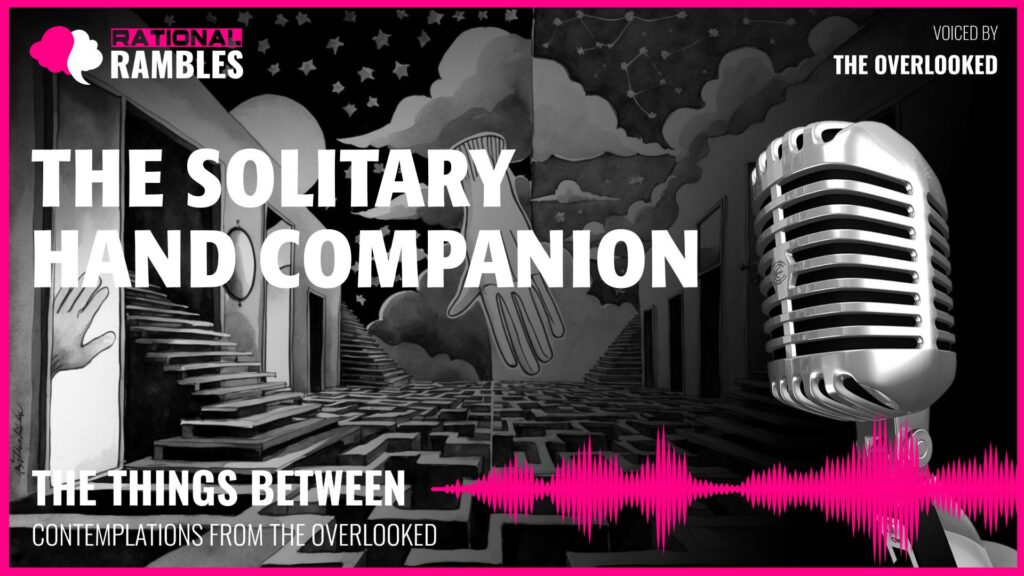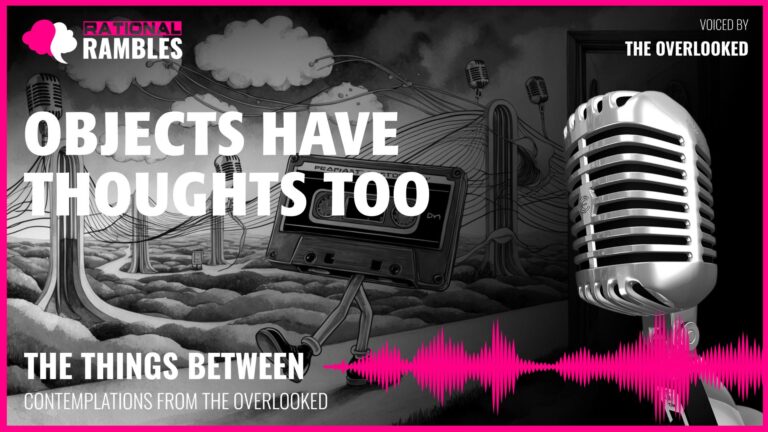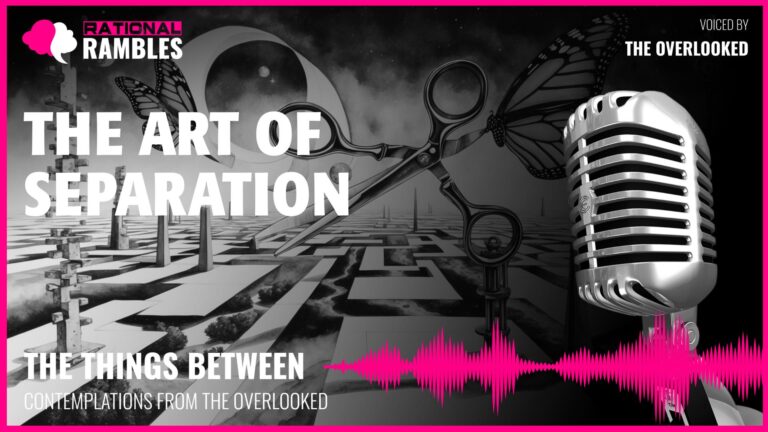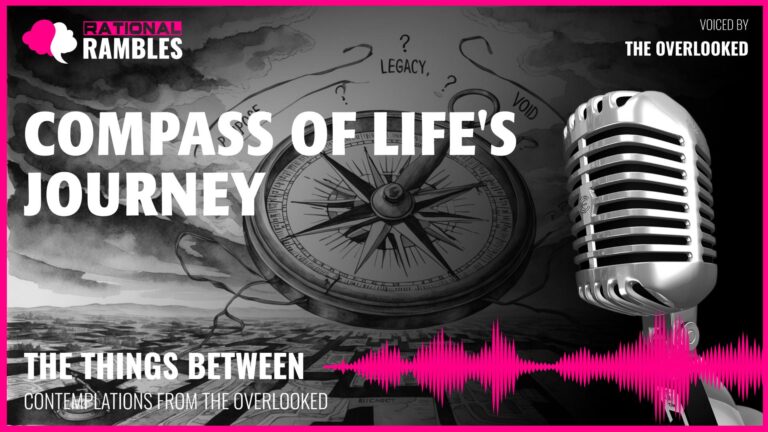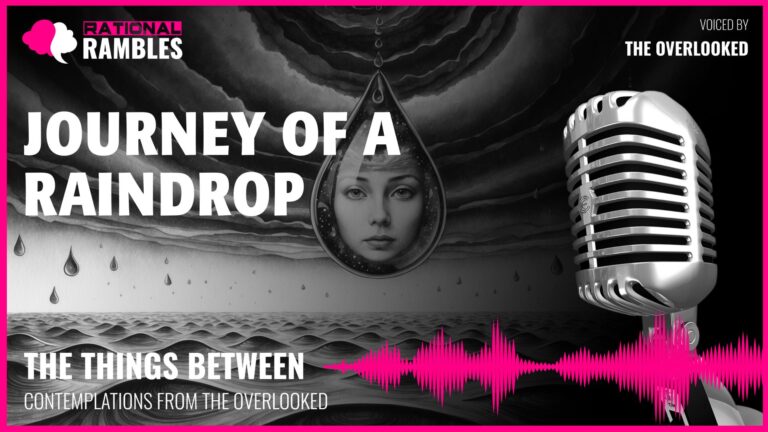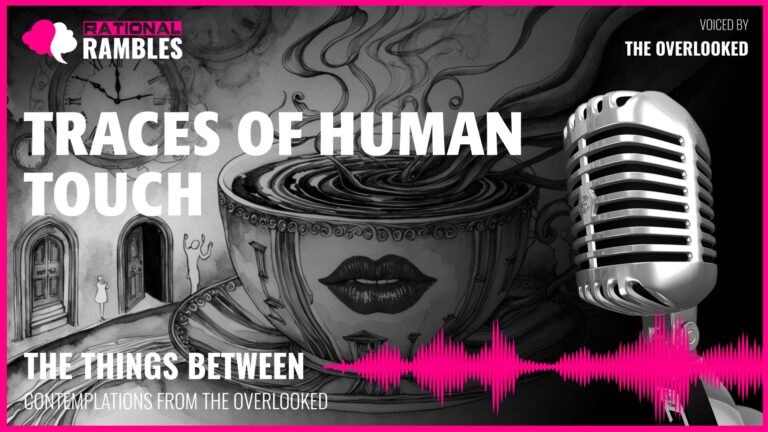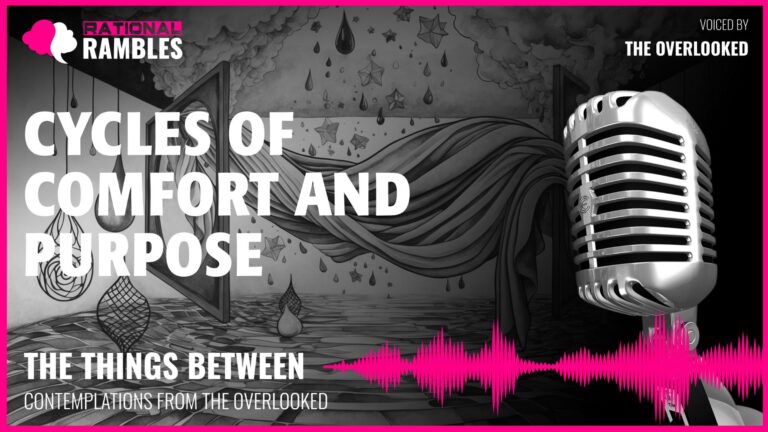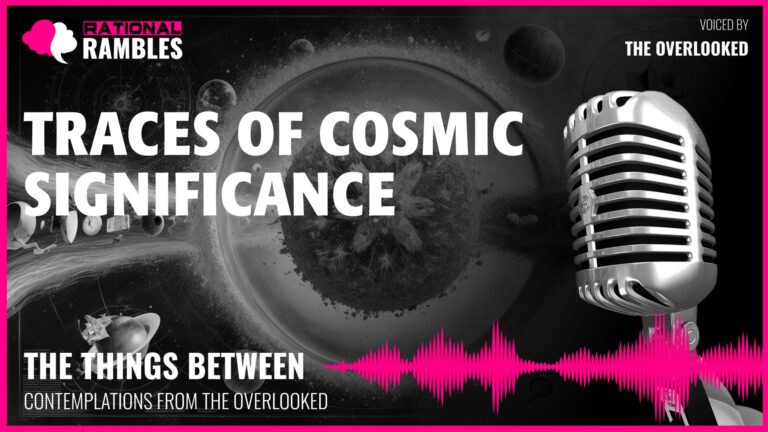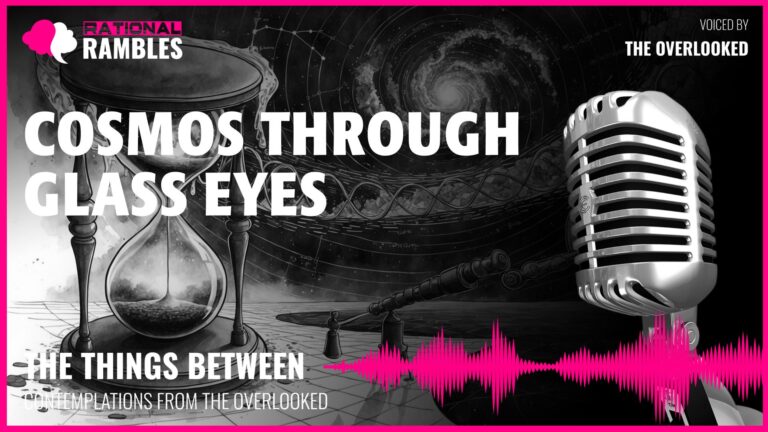Duality and Incompleteness: The Search for Wholeness in a Fragmented Existence
Introduction
In the quiet corners of human experience lies a profound paradox: we are simultaneously whole beings and yet inherently incomplete. This duality of existence—being both sufficient unto ourselves and yearning for connection—forms the foundation of our most meaningful philosophical inquiries. What does it mean to be whole? Is completeness a physical state, or does it exist primarily in relation to something outside ourselves? Can we find meaning and purpose in our incompleteness, or must we constantly seek to fill the hand-shaped voids within our lives?
These questions transcend the boundaries of abstract philosophy, touching upon the lived reality of human experience. We are beings designed for connection, shaped by evolution and culture to seek out relationships, partnerships, and communities. Yet we also experience profound periods of solitude and separation, moments when we must confront our independent existence and find meaning in our singularity.
This philosophical exploration delves into the nature of duality, identity, and purpose. It examines how completeness might be understood not merely as a state of being physically whole, but as a relational concept that emerges through connection with others. It considers the dignity that can be found in maintaining one’s essence despite being separated from one’s counterpart, and the possibility that incompleteness itself may harbor unique forms of meaning unavailable to those who remain perfectly paired.
Through this journey, we will discover that the tension between wholeness and incompleteness is not simply a problem to be solved, but rather a fundamental aspect of existence that can illuminate the deepest questions of what it means to be.
The Paradox of Being Complete Yet Incomplete
Human existence is marked by a curious contradiction: we are physically complete organisms, yet we experience a persistent sense of incompleteness. This paradox has occupied philosophers since antiquity, from Plato’s myth of the divided beings in the Symposium to modern existentialist explorations of fundamental lack.
Physical Wholeness and Existential Lack
Consider how we experience ourselves: anatomically whole yet emotionally seeking. We possess all necessary biological components for survival, yet we persistently sense something missing. Jean-Paul Sartre characterized this as an essential aspect of human consciousness—a persistent lack driving our engagement with the world. In Being and Nothingness, he suggests that human reality is haunted by an absence, a “nothingness” that propels us into constant becoming rather than simply being.
This existential incompleteness feels paradoxical because it coexists with our physical completeness. We are not damaged or broken in any objective sense, yet we experience ourselves as somehow insufficient, curved and shaped precisely for something that isn’t there. This hollowness with purpose—to be filled—defines much of human experience.
The Form of Absence
What is particularly fascinating about this human condition is that our sense of incompleteness takes specific shapes. We do not merely feel generically incomplete; rather, we experience precisely contoured absences. We miss particular relationships, yearn for specific connections, and feel the absence of certain purposes or meanings. These absences are not formless voids but highly structured spaces of potential—hand-shaped hollows waiting to be filled.
German philosopher Martin Heidegger addressed this phenomenon through his concept of “thrownness” (Geworfenheit), the idea that humans find themselves already situated in a world of relationships and possibilities that shape the specific contours of their existential longings. Our incompleteness is not random but structured by our historical, cultural, and personal contexts.
The specificity of our incompleteness raises profound questions: Is the shape of our absence predetermined? Are we, like paired objects, designed with particular complementarities in mind? Or do we shape our hollows through experience, gradually defining what we lack through encounters with what we temporarily possess?
The Integrity of Incompleteness
Perhaps most remarkably, we maintain our integrity despite this persistent sense of incompleteness. We continue to function, to maintain our identities, to persist in our essential nature even when separated from what seems to complete us. This suggests a profound dignity in incompleteness—a capacity to maintain shape despite emptiness, to preserve identity despite absence.
Existentialist philosophers like Albert Camus embraced this aspect of the human condition. In works like The Myth of Sisyphus, Camus argues that meaning can be found not in overcoming absurdity and incompleteness but in fully acknowledging and embracing them. There is integrity, even nobility, in maintaining one’s essence despite the persistent experience of lack.
This paradoxical state—being simultaneously whole and incomplete—may not be a problem to solve but rather a fundamental condition to understand. It suggests that completeness and incompleteness are not opposing states but complementary aspects of a complex existence. We are, perhaps, most authentically ourselves when we acknowledge both our wholeness and our hollowness.
The Ontology of Pairs: Duality in Nature and Design
The principle of duality permeates our world, from the fundamental structures of nature to the intentional designs of human artifacts. This prevalence of pairs suggests something essential about the structure of reality and raises profound questions about the meaning of complementarity and completion.
Duality in Natural Structures
Throughout the natural world, we observe the recurring phenomenon of bilateral symmetry. The human body exemplifies this principle with its paired organs: eyes, ears, lungs, kidneys, limbs. This structural duality appears to serve both functional and evolutionary purposes. Two eyes provide depth perception through stereoscopic vision; two ears enable directional hearing; paired limbs offer balance and coordinated movement.
Beyond the obvious functional advantages, this natural pairing suggests a deeper principle of complementarity. In quantum physics, Niels Bohr’s principle of complementarity recognizes that particles can be understood as both waves and particles—two complementary descriptions necessary for a complete understanding. Similarly, biological systems often achieve completeness through complementary pairs: inhale and exhale, systole and diastole, the binary code of DNA.
The Taoist concept of yin and yang recognizes this fundamental duality, seeing complementary opposites as interdependent aspects of a unified whole. The principle suggests that pairs are not merely convenient arrangements but essential expressions of a deeper cosmic order where wholeness emerges from the balance of complementary forces.
Intentional Pairing in Human Design
Humans extend this natural principle of pairing into intentional design. We create objects that come in complementary pairs: gloves, shoes, earrings, bookends. These designed pairs differ from simple duplicates; they are often mirror images, specifically created to complement rather than replicate. This distinction reveals a profound understanding of complementarity—recognizing that true completion sometimes requires difference rather than sameness.
When we design paired objects, we embed in material form our intuitive understanding of complementarity. A pair of gloves, for instance, achieves its complete functionality only when both the left and right are present. Each is whole in itself—every stitch intact, every seam complete—yet functionally incomplete without its counterpart. This designed incompleteness reflects our implicit recognition that some forms of wholeness can only emerge through relationship.
The Philosophical Implications of Duality
The prevalence of pairs in both nature and design raises profound philosophical questions about the nature of completeness. Is duality merely a convenient functional arrangement, or does it reflect something more fundamental about the structure of reality? Are we, like the objects we design, fundamentally incomplete without our complementary others?
Philosophers from Plato to Hegel have grappled with these questions. Plato’s myth in the Symposium suggests that humans were once whole beings who were split apart, their fragmented nature driving an eternal search for their other half. Hegel’s dialectical philosophy sees all of reality as structured by the tension and resolution of opposites, with genuine completeness emerging only through the synthesis of complementary aspects.
Contemporary philosopher Emmanuel Levinas takes this further, arguing that the self is fundamentally constituted through its relationship to the Other. For Levinas, we become fully ourselves not in isolation but in ethical relationship with those who are different from us. This suggests that human completeness is not self-contained but emerges through the encounter with difference.
The philosophical examination of pairs thus leads us to a profound recognition: perhaps completeness is not a state of isolated self-sufficiency but a relation between complementary entities. Just as a single glove achieves its full meaning and purpose only in relation to both its counterpart and the hand it is designed to protect, perhaps our own completeness emerges not from self-containment but from our connections to what complements us.
Identity in Separation: Maintaining Essence Despite Circumstance
What constitutes identity when an entity is separated from its defining relationships? This question probes the boundaries between essence and circumstance, challenging us to consider what remains when connection is severed, and what changes when context is altered.
The Persistence of Essential Nature
There exists a remarkable dignity in maintaining identity despite separation from defining relationships. Consider how a single glove, though separated from both its counterpart and the hand it was designed to cover, remains unmistakably a glove. Its fingers still curl expectantly, its palm still forms a perfect concave embrace. Though inactive in its intended purpose, it persists in a state of perpetual readiness, maintaining its essential nature despite circumstances that prevent its function.
This persistence suggests that identity runs deeper than current activity or relational context. Aristotle distinguished between potentiality and actuality, arguing that an entity’s essence includes not just what it currently does but what it has the capacity to do. A musician remains a musician even while sleeping; a philosopher remains a philosopher even in silence. The maintenance of potential may be as important to identity as the exercise of function.
Maurice Merleau-Ponty’s phenomenology offers insight here through his exploration of the body schema—the pre-reflective awareness of our bodies’ capacities that persists even when those capacities are not being exercised. Just as we maintain an implicit awareness of our ability to walk even when sitting still, perhaps objects maintain their essential identity through the persistence of their potential functions, even when those functions remain unexercised.
Transformation Through Isolation
While essential nature may persist through separation, isolation nevertheless transforms. A solitary glove, though maintaining its physical identity, undergoes a profound shift in its relation to the world. No longer participating in active function, it enters a contemplative state, becoming an object of reflection rather than use. This transformation—from tool to totem, from instrument to artifact—reveals how separation can catalyze new forms of meaning.
Martin Heidegger’s distinction between “ready-to-hand” and “present-at-hand” illuminates this transformation. An object in use (ready-to-hand) disappears into its function, while an object removed from use (present-at-hand) emerges into conscious awareness, becoming available for contemplation and theoretical understanding. Separation thus can transform an entity from an invisible extension of purpose to a visible object of reflection.
This suggests that isolation, while potentially depriving an entity of its primary function, may simultaneously open new possibilities for meaning. The separated entity may develop forms of significance unavailable to its functional counterpart, becoming not less but differently meaningful. A glove in use disappears into functionality; a solitary glove appears as an object of contemplation, perhaps revealing aspects of existence invisible to its actively employed twin.
The Question of Recognition
Separation raises poignant questions about recognition and remembrance. Would entities long separated recognize their counterparts if reunited? Time changes materials—colors fade, textures alter, patterns wear differently depending on use or disuse. Two objects once identical might, through their different journeys, become physically distinct.
This material transformation parallels the philosophical ship of Theseus problem: if all components of an entity are gradually replaced, does it remain the same entity? The question extends to relationships as well: if two once-connected entities undergo separate transformations, can they ever truly reconnect as the same pair?
These questions highlight the temporal dimension of identity—the tension between persistence and change that characterizes existence through time. The paradox of identity through change has occupied philosophers from Heraclitus to Derek Parfit. Perhaps identity is neither absolute persistence nor complete transformation, but a complex interweaving of continuity and change, recognition and discovery.
The dignity of maintaining identity despite circumstance thus reveals something profound about existence itself. We are defined not merely by our current functions or relationships, but by a persistent essence that endures through separation and change. Yet this essence is not static; it evolves through circumstance while maintaining a recognizable continuity. In this tension between persistence and transformation lies the complex nature of identity itself.
The Teleology of Absence: Purpose in Incompleteness
Can absence itself have purpose? This question invites us to consider whether incompleteness might not merely be a deficiency to overcome but might itself serve meaningful functions in our understanding of ourselves and our world.
The Productive Power of Absence
Absence has a peculiar generative quality. A single glove, through its very incompleteness, creates a narrative tension that a complete pair does not. It provokes questions, inspires searches, suggests stories. It asks implicitly: “Where is your other half?” In this way, incompleteness does not merely subtract from meaning but actively produces new forms of significance.
This productive power of absence appears throughout human experience. In literature, ellipses and gaps in narration often generate more engagement than explicit telling. In music, the silences between notes create rhythm and anticipation. In relationships, distance can intensify connection rather than merely diminishing it.
Jacques Derrida’s concept of “différance” illuminates this phenomenon, suggesting that meaning emerges not from presence alone but from the play of presence and absence, identity and difference. Absence is not merely the negation of presence but an active force in the creation of meaning. The gap, the lack, the missing element becomes not a void but a generative space from which new possibilities emerge.
Absence as Monument to Potential
Incompleteness serves as a persistent reminder of what could be—a monument to potential rather than a mere marker of deficiency. A single glove, maintaining its shape despite emptiness, embodies in its very form the possibility of completion. Its curved fingers and hollowed palm stand as testimony not just to what is missing but to what might yet be.
Ernst Bloch’s philosophy of hope provides insight here. Bloch saw incompleteness not as a defect but as an opening toward future possibility. The “not-yet” becomes a positive category, a space of anticipation and potential that drives human creativity and aspiration. Similarly, a solitary glove exists in a state of perpetual “not-yet”—not yet reunited with its counterpart, not yet enveloping a hand—that preserves possibility as an active presence rather than a mere absence.
This perspective suggests that incompleteness itself may be teleological—directed toward an end or purpose. The purpose of incompleteness may be precisely to maintain openness to possibility, to resist premature closure, to preserve the potential for new forms of completion not yet imagined.
The Aesthetic of the Incomplete
Throughout art history, we find a recurring appreciation for the aesthetic power of the incomplete. From the partial sculptures of classical antiquity to the deliberately unfinished paintings of the Romantics, from the fragmentary poetry of Sappho to the elliptical narratives of modernist literature, incompleteness has been recognized as a distinct aesthetic value rather than a mere deficiency.
Japanese aesthetic traditions particularly emphasize this through concepts like wabi-sabi (the beauty of imperfection and transience) and ma (the meaningful space between elements). These traditions recognize that completion can sometimes diminish rather than enhance meaning—that the gap, the fragment, the partial glimpse often evokes more profound engagement than the fully realized and explicitly stated.
This aesthetic sensibility suggests that incompleteness may serve an important purpose in our perceptual and conceptual engagement with the world. By resisting closure, the incomplete invites participation, interpretation, and co-creation. A complete pair of gloves asks nothing of the observer; a single glove invites the imagination to supply what is missing, engaging the observer in an act of creative completion.
Through these perspectives, we begin to see absence not merely as lack but as a productive force with its own teleology. The purpose of incompleteness may not be simply to become complete in predetermined ways, but to maintain openness to multiple forms of potential completion, to generate questions rather than merely awaiting answers, and to engage others in the collaborative creation of meaning. In this sense, incompleteness may be not a state to transcend but a generative condition to embrace.
Symbiosis and Mutual Becoming: Relationships as Transformative
The relationship between complementary entities involves more than mere adjacency or functional coordination. At its deepest level, such relationship involves a mutual transformation where each entity both shapes and is shaped by its counterpart.
The Dance of Mutual Influence
When a hand slides into a glove, a remarkable process unfolds: the hand gains protection while the glove gains animation. Yet this exchange goes beyond simple transaction. The glove conforms to the hand’s every gesture, while simultaneously altering the hand’s experience—modifying its sensations, limiting some movements while enabling others. Neither remains unchanged by the encounter; both are transformed through their connection.
This mutual influence characterizes all deep relationships. Martin Buber’s philosophy of dialogue captures this through his distinction between “I-It” and “I-Thou” relationships. In an “I-It” relation, the other remains merely an object, unchanged and unchanging. In an “I-Thou” encounter, both entities enter a space of mutual becoming, each transformed through genuine meeting with the other.
Developmental psychologists like D.W. Winnicott observe this process in human development, noting how infant and caregiver mutually create each other through their interactions. The caregiver shapes the infant’s developing mind, while the infant’s responses reshape the caregiver’s identity and behaviors. Neither is merely acting upon the other; both are engaged in a dance of mutual constitution.
Beyond Complementarity to Co-creation
This understanding of relationship transcends simple complementarity. It’s not merely that two entities complete each other in static ways, like puzzle pieces fitting together. Rather, they actively co-create each other through ongoing interaction. The relationship becomes not just a connection between two complete entities but a generative space where both continue to evolve.
Philosopher Gilles Deleuze captures this dynamic through his concept of “becoming” as opposed to “being.” For Deleuze, entities are not fixed essences that enter into relationships; rather, they are continually constituted through their relationships. A hand in a glove is not simply a hand with something added; it becomes a different kind of hand—experiencing the world differently, moving differently, relating differently to its environment.
Similarly, contemporary feminist philosophers like Donna Haraway emphasize how relationships change the very nature of the entities involved. Her concept of “sympoiesis” (making-with) suggests that beings do not preexist their relationships but are constituted through them. We are not autonomous individuals who sometimes enter relationships; we are fundamentally relational beings whose very selfhood emerges through connection.
The Intimacy of Mutual Formation
There is a profound intimacy in this process of mutual becoming—an intimacy that transcends mere physical closeness. When entities shape each other through relationship, they carry traces of each other even when separated. A hand bears the memory of gloves that have covered it; a glove maintains the imprint of hands it has enveloped.
Maurice Merleau-Ponty’s concept of “intercorporeality” illuminates this phenomenon—the idea that bodies are fundamentally open to and intertwined with each other and their environments. For Merleau-Ponty, the boundaries between self and other, organism and environment, are porous rather than absolute. We flow into each other through our interactions, each leaving impressions that persist beyond the moment of contact.
This intimacy of mutual formation suggests that even when separated, entities remain marked by their relationships. A solitary glove, though physically separated from both its counterpart and the hands it once covered, carries these relationships within its very form. Its shape, its wear patterns, the particular way its materials have conformed to use—all bear witness to the relationships that have shaped it.
Understanding relationships as transformative rather than merely connective changes how we conceptualize both connection and separation. If relationships fundamentally alter who and what we are, then no separation is ever complete. We carry our relationships within us, our very structures bearing witness to the connections that have formed us. And in this sense, perhaps no entity—not even a solitary glove—is ever truly alone.
The Ethics of Attachment and Loss
How should we relate to the inevitability of separation? This question lies at the heart of both philosophical ethics and lived human experience, challenging us to develop meaningful orientations toward attachment and loss.
The Paradox of Attachment
Attachment presents us with a fundamental paradox: the same connections that give our lives meaning and purpose also render us vulnerable to suffering through loss. To care deeply is to risk deeply; to form attachments is to create the conditions for grief. Yet a life without attachment—a life of complete self-sufficiency—seems to miss something essential about human flourishing.
The Stoic philosophers recognized this dilemma, advocating for an ethical stance of detachment. Epictetus advised distinguishing between what we can and cannot control, arguing that wisdom consists in relinquishing attachment to what lies beyond our power. For the Stoics, suffering arises not from loss itself but from our resistance to the natural impermanence of all relationships.
Buddhist philosophy offers a similar analysis through its concept of attachment (upadana) as a source of suffering. The Buddha taught that suffering arises from craving and clinging to impermanent phenomena. Yet importantly, the Buddhist solution is not cold detachment but compassionate engagement—forming relationships while maintaining awareness of their impermanence.
Meaningful Responses to Loss
How might we respond meaningfully to the inevitable separations that punctuate existence? We observe various human responses: some frantically search for what is lost, some preserve what remains in hope of reunion, some adapt by finding new connections, and some find meaning in the very experience of absence.
The frantic search represents a resistance to loss—a refusal to accept separation as real or final. We see this in the person who empties pockets and retraces steps after losing a glove. This response, while sometimes practical, can become pathological when it prevents engagement with present reality. Yet it also reflects something profound: a recognition of the value of what is lost and a refusal to casually accept its absence.
The preservation of what remains—keeping a single glove in case its partner reappears—represents a stance of hopeful waiting. This response maintains openness to the possibility of reunion without actively pursuing it. French philosopher Gabriel Marcel distinguished between “problem” and “mystery,” suggesting that some experiences cannot be solved but must be approached with patient openness. Preservation embodies this patient openness to possibilities beyond our control.
Adaptation through new connections—finding new uses for what remains or establishing new relationships—represents a creative response to loss. This approach neither denies the reality of loss nor remains fixated upon it, but rather incorporates it into ongoing life. This aligns with existentialist ethics as articulated by Simone de Beauvoir, which emphasizes creative response to the givens of our situation rather than either submission to or denial of them.
Finding Meaning in Absence
Perhaps most profoundly, some discover that absence itself can become meaningful—not merely as lack but as a distinct form of presence. A solitary glove becomes not just a remnant of a lost pair but an object of contemplation in its own right, revealing aspects of existence that completeness might obscure.
This perspective resonates with Martin Heidegger’s exploration of “the nothing” as not merely the negation of being but a distinct phenomenon that reveals being in particular ways. For Heidegger, anxiety brings us face to face with nothingness, but this encounter can disclose the world to us in new ways rather than simply depriving us of meaning.
Similarly, absence can disclose aspects of existence invisible from the perspective of completion. The empty space within a solitary glove reveals the particular shape of what is missing. The silence after a voice falls quiet makes audible the precise cadence of what has been lost. Absence becomes not merely a void but a precise negative space that preserves the contours of what is no longer present.
These various responses to loss suggest that there is no single ethical stance that adequately addresses the complexity of attachment and separation. Perhaps wisdom consists not in adopting one stance to the exclusion of others, but in developing the capacity to move between them—to search when searching is appropriate, to preserve when preservation serves hope, to adapt when adaptation enables flourishing, and to find meaning in absence when absence itself becomes revelatory.
The ethics of attachment and loss thus leads us not to a single answer but to a complex responsiveness that honors both the value of connection and the reality of impermanence, both the pain of separation and the possibility of finding meaning within and beyond it.
Time and Transformation: Dust as Marker and Connector
The passage of time registers in visible ways, marking both absence and presence, separation and connection. For a stationary object, dust becomes a particularly profound marker of temporal experience—each particle a tiny testimony to duration, abandonment, and subtle forms of worldly connection.
Dust as Chronology
Time passes differently when measured not by clocks or calendars but by the slow accumulation of dust. This alternative chronology unfolds at a pace almost imperceptible in moment-to-moment experience, becoming visible only through the perspective of duration. A thin layer of dust might represent days; a thick coating might mark years or decades.
Henri Bergson’s distinction between “clock time” and “duration” illuminates this phenomenon. Clock time divides experience into uniform, quantifiable units; duration captures the qualitative, heterogeneous flow of lived experience. Dust accumulation embodies duration rather than clock time—a continuous, non-uniform process sensitive to the particularities of environment and circumstance.
This dust-chronology reveals something profound about temporality itself: time is not merely an abstract dimension but materializes in the physical world. In Heidegger’s terminology, dust makes visible the “worlding of the world”—the ongoing material processes through which existence unfolds. Time is not separate from matter but manifests through material transformation.
Markers of Abandonment and Attention
Dust accumulation often signifies abandonment—the absence of the attentive touch that would otherwise remove it. A dust-covered object has not been handled, used, or cleaned; it has been allowed to settle into a relationship with time unmediated by human intervention.
Yet dust also registers more subtle forms of relationship. Its patterns reveal air currents, the movement of other objects, the comings and goings of living beings. Dust accumulates differently in frequented spaces versus abandoned ones, in draft paths versus still corners. It records not just the absence of direct attention but the entire environmental context of its situation.
This dual nature of dust—marking both abandonment and environmental relationship—suggests that no object is ever entirely abandoned. Even in solitude, even in neglect, objects remain participants in material systems, responsive to and recording the subtle influences of their surroundings.
Dust as Connector
Beyond marking time and abandonment, dust serves a more positive function: it connects. Each dust particle arrives from elsewhere, bringing microscopic news of the wider world. Dust contains skin cells from living beings, pollen from plants, minerals from distant soils, particulate matter from industrial processes. It is a material archive of the environments through which it has passed.
Through dust, an isolated object maintains a material connection to the broader world. A solitary glove gathering dust on a shelf is not entirely alone; it hosts countless tiny visitors, each bringing traces of elsewhere. This microscopic community creates a form of connection distinctly different from functional partnership but connection nonetheless.
Contemporary philosopher Jane Bennett’s concept of “vibrant matter” helps us understand this phenomenon. Bennett argues that matter is not inert but lively, engaged in constant processes of interaction and transformation. Dust exemplifies this vibrancy—a dynamic, interactive material system rather than a static coating of inert particles.
Through this lens, dust appears not as mere degradation but as a form of integration—a process through which separated objects gradually rejoin the material flows from which they emerged. A manufactured object like a glove begins its existence as distinctly bounded, separated from the material continuum through human design and production. As dust accumulates, these boundaries begin to blur; the object gradually reintegrates with the material systems it temporarily left through manufacturing.
Transformation Through Time
Time transforms not just through dramatic events but through these subtle, accumulative processes. An object long separated from its counterpart undergoes gradual change—its colors fade, its materials age, its surfaces accumulate these microscopic visitors. Over sufficient time, these transformations might render original pairs unrecognizable to each other.
This material transformation parallels philosophical questions about identity through time. The ship of Theseus problem asks whether an object remains the same if all its components are gradually replaced. Similarly, we might ask whether a glove remains the same pair-member after years of separate existence have transformed its material composition.
Such questions reveal time’s paradoxical nature—both preserving and transforming, connecting and separating. Time simultaneously maintains continuity (the glove remains recognizably a glove) while enabling profound change (its material composition gradually alters). This paradox suggests that transformation and persistence are not opposed but interdependent aspects of temporal existence.
Dust, as time’s visible register, thus reveals profound truths about existence itself. We are all, like dust-gathering objects, simultaneously abandoned and connected, separated and integrated, persistent and transforming. In the slow accumulation of dust, we glimpse not just the passage of time but the complex material interdependence that characterizes all existence.
Potential and Actual: Alternative Modes of Existence
What is the relationship between what something is and what it could be? This question probes the ontological status of potential—whether possibility represents a genuine mode of existence or merely a subjective projection onto reality.
The Reality of the Possible
When we encounter an object removed from its intended function—a solitary glove, for instance—we perceive not just its present reality but the ghost of its potential. We see both what it is and what it could be, the actual object and its possible uses. This suggests that potential has a kind of reality, existing not merely in imagination but as an aspect of the object itself.
Aristotle distinguished between potential (dynamis) and actual (energeia) as fundamental modes of being. For Aristotle, potential is not merely subjective projection but an objective property of entities—the acorn genuinely contains the potential of the oak tree; the child genuinely contains the potential of the adult. This potential is not nothing; it is a real aspect of the entity’s being, though different from its actuality.
Contemporary philosopher Giorgio Agamben extends this analysis, arguing that potential includes not just the capacity to become actual but also the capacity not to become actual—what he calls “the potentiality not to.” A pianist preserves potential not just while playing but perhaps more profoundly while not playing, maintaining the capacity that defines their identity even in its non-exercise.
This perspective suggests that a solitary glove maintains its potential—its capacity to warm a hand, to pair with its counterpart—even when that potential remains unactualized. This potential is not merely imaginary but constitutes a genuine mode of the glove’s existence, as real in its way as its actual material properties.
The Dignity of Persistent Readiness
There is a peculiar dignity in maintaining readiness despite extended inactivity. A glove that preserves its shape—fingers curved expectantly, palm forming its concave embrace—despite years without use demonstrates a persistent potentiality that transcends circumstance.
This persistent readiness parallels certain ethical and existential stances. The Stoic concept of readiness for whatever comes (paraskeuē) involves maintaining proper disposition regardless of external circumstances. Similarly, Heidegger’s concept of “resoluteness” (Entschlossenheit) involves maintaining readiness for authentic response to possibility, even when such possibilities remain distant or unrealized.
Such readiness represents not passivity but an active maintaining of capacity. The glove that preserves its shape despite emptiness is not merely waiting but actively maintaining its potential, preserving its capacity to fulfill its purpose should circumstances change. This suggests that potential involves not merely abstract possibility but concrete preparedness—a bodily readiness that persists through time.
Alternative Forms of Purpose
While objects may be designed for specific functions, they often discover alternative purposes through changing circumstances. A solitary glove might become a puppet, a polishing cloth, a container for small objects, or an art piece. These alternative purposes suggest that potential exceeds original design, opening toward possibilities not anticipated in creation.
This phenomenon aligns with what philosopher Gilbert Simondon calls “technical evolution”—the process through which technical objects develop purposes beyond their original design through changed contexts and novel applications. For Simondon, technical objects are never fully determined by their initial purpose but retain openness to evolution through new relationships and applications.
Similarly, anthropologist Tim Ingold argues that the properties of materials exceed the intentions of their makers, always opening toward potential uses not anticipated in design. A wooden table is designed for dining, but the properties of wood—its texture, resonance, combustibility—open toward countless other potential applications from musical instrument to fuel.
This perspective suggests that even highly specialized objects like a glove maintain openness to purposes beyond their original design. Their potential exceeds their intended actuality, creating space for evolution, adaptation, and discovery. The solitary glove may find actuality in ways its creators never imagined.
Contemplation as Actualization
Perhaps most intriguingly, objects removed from practical function may discover a new form of actualization through becoming objects of contemplation. A glove in use disappears into its utility; a solitary glove appears as an object of philosophical reflection, revealing aspects of existence invisible to pragmatic attention.
Heidegger distinguishes between equipment “ready-to-hand” (zuhanden) and “present-at-hand” (vorhanden). Tools functioning as intended become transparent, while broken or removed tools emerge into visibility, becoming available for theoretical attention. This shift represents not merely a change in subjective attitude but a genuine transformation in the object’s mode of being.
Through this lens, the solitary glove actualized as an object of contemplation is not merely a failed or incomplete version of a functional glove but an entity with its own distinct mode of being. Its purpose has transformed from practical utility to philosophical revelation—from tool to teacher, from equipment to exemplar.
This suggests that potential and actual are not fixed categories but fluid, contextual modes of existence. An object’s potential includes not just its designed function but all possible relationships it might enter, including becoming an object of contemplation that reveals philosophical truths. In becoming such an object, the solitary glove actualizes a potential that may be invisible to its actively employed counterpart—the potential to illuminate the nature of existence itself.
Belonging and Rightful Place: The Philosophy of Location
What does it mean to be “in the right place”? This question extends beyond physical location to encompass deeper questions of purpose, relation, and alignment with an entity’s essential nature.
The Duality of Belonging
The concept of “belonging” contains a revealing duality: it refers both to possession (“this glove belongs to someone”) and to proper placement (“this glove belongs on a hand”). This linguistic connection suggests a profound relationship between ownership and rightful location—between being possessed and being properly situated.
Martin Heidegger explores this connection through his analysis of “belonging-together” (Zusammengehören). For Heidegger, authentic belonging involves not just adjacency or possession but a fundamental correspondence between entities that allows each to manifest its essential nature. When things truly belong together, each enables the other to be what it most authentically is.
This perspective suggests that a glove “belongs” on a hand not merely as a matter of function or ownership but as a relationship that allows both glove and hand to manifest their essential natures. The hand protected and extended by the glove becomes more fully a hand in certain respects; the glove animated by the hand becomes more fully a glove. Their belonging-together enables a mutual fulfillment of potential.
Place as Relational Rather Than Absolute
Where does something truly belong? This question suggests that rightful place is not an absolute location but a relational position—a place defined by connection to other entities rather than by objective coordinates. A glove belongs not at a specific geographical point but in relation to both its counterpart and the hand it is designed to cover.
Aristotle’s concept of “natural place” offers insight here. For Aristotle, each element has a natural place toward which it tends—earth toward the center, fire toward the periphery. This place is defined not by absolute location but by relation to the cosmic order. Similarly, an entity’s rightful place may be defined not by fixed coordinates but by its proper relations within a broader system.
Contemporary philosopher Edward Casey extends this relational understanding of place, arguing that places are not merely locations but complex intersections of physical setting, social relations, personal history, and cultural meaning. A place is not where something is but how it is situated within multiple overlapping contexts.
This relational understanding of place suggests that displacement is not merely physical separation but disruption of proper relations. A glove displaced from both its counterpart and the hand it is designed to cover experiences not just physical relocation but ontological displacement—a separation from the relations that enable it to manifest its essential nature.
The Ethics of Proper Placement
Does everything have a “right place”? This question extends beyond description to encompass ethical considerations of how entities ought to be situated. Does the concept of rightful place imply an ethical obligation to maintain or restore proper relations?
Classical ethical traditions often include concepts of proper order. Confucian ethics emphasizes the importance of each person fulfilling their proper role within social relations. Aristotelian virtue ethics locates goodness in proper function according to essential nature. These traditions suggest that proper placement—enabling entities to fulfill their essential nature through right relation—constitutes an ethical good.
Yet contemporary ethics often emphasizes autonomy, self-determination, and the freedom to define one’s own “place” rather than accepting predetermined positions. This tension raises important questions: Is the “right place” for an entity determined by its nature, by its own preferences, by social consensus, or by some combination of these factors?
A solitary glove presents this ethical question concretely. Is there an ethical imperative to reunite separated pairs, to restore objects to their functional contexts? Or might there be equal validity in allowing entities to develop new forms of placement and purpose through changed circumstances?
Finding Place Beyond Original Purpose
While entities may have designed purposes that suggest particular placements, many discover alternative forms of belonging beyond original design. A solitary glove might find new “right places”—as a dust rag, as a protective covering for delicate objects, as an art piece, or as an object of philosophical contemplation.
Anthropologist Claude Lévi-Strauss’s concept of “bricolage” illuminates this phenomenon—the creative repurposing of objects beyond their intended use. For Lévi-Strauss, this represents not mere utility but a distinct form of intelligence that recognizes potential beyond designed purpose.
Similarly, new materialist philosophers like Jane Bennett emphasize the agency of matter in discovering novel forms of relation beyond human intention. Materials and objects participate in their own placement, forming connections and finding uses that exceed design and intention.
This perspective suggests that rightful place is not fixed by original purpose but evolves through an entity’s journey through the world. A glove’s “right place” might initially be on a specific hand paired with its counterpart, but this place might evolve through changing circumstances—the glove discovering new forms of belonging beyond its initial purpose.
The philosophy of location thus leads us to understand belonging not as a fixed relation but as a dynamic process of finding fit within changing circumstances. Rightful place emerges not from abstract designation but through the ongoing negotiation between an entity’s nature, its history, its current context, and its potential futures. The question “Where do I belong?” remains perpetually open, answered not once but continuously through the journey of existence.
Conclusion: Wholeness Within Incompleteness
Our philosophical journey through the landscapes of duality, absence, and belonging returns us to our original question: Can one be simultaneously whole and incomplete? The exploration suggests not a simple answer but a profound reframing of the question itself.
Beyond the Binary of Completeness and Incompleteness
The dichotomy between completeness and incompleteness reveals itself as overly simplistic. Just as quantum entities exhibit wave-particle duality, existential wholeness and incompleteness appear not as opposing states but as complementary aspects of a complex reality.
A solitary glove demonstrates this complementarity. Physically intact yet functionally incomplete; separated from its counterpart yet maintaining its essential identity; removed from its intended purpose yet discovering new forms of meaning. Its existence transcends simple categorization as either complete or incomplete.
This suggests that completeness itself might be reconceptualized—not as a final state of perfect self-sufficiency but as an ongoing process of integration that incorporates both connection and separation, both fulfillment and absence. Perhaps wholeness consists not in the absence of incompleteness but in the authentic embracing of the entire spectrum of existence, including the experience of absence and longing.
Completeness as Authentic Embrace of Circumstance
If completeness is reconceived not as perfect fulfillment but as authentic embrace of circumstance, then even a solitary glove might achieve a form of wholeness through fully becoming what it now is—not merely a fragment of a former pair but an entity with its own distinct mode of being.
Existentialist philosophers like Sartre and de Beauvoir emphasize authentic engagement with circumstance over conformity to predetermined essence. For them, human completeness emerges not through fulfilling fixed potential but through authentic response to the concrete situations in which we find ourselves.
Similarly, a glove separated from its counterpart might discover wholeness not through reunion but through authentic embrace of its solitary state—becoming fully what it now is rather than remaining defined by what it no longer has. Its fingers that once held a hand might now hold memories, its fabric that once blocked wind might now gather the gentle accumulation of dust-time, its form that once completed a pair might now complete a philosophical reflection.
The Transformative Potential of Absence
Throughout this exploration, we have discovered that absence is not mere negation but a transformative force with its own distinctive powers. Absence creates narrative tension, preserves possibility, generates questions, and reveals aspects of existence invisible from the perspective of completion.
A glove filled by a hand disappears into functionality; a solitary glove appears as an object of contemplation, revealing truths about identity, purpose, time, and relation that might remain invisible to its actively employed counterpart. This suggests that incompleteness itself may enable forms of significance unavailable to that which remains perfectly paired and functionally engaged.
Perhaps there is a wisdom that emerges only through the experience of separation—a perspective available only to that which has known both connection and solitude. The solitary glove, having experienced both partnership and separation, both function and contemplation, may access a more comprehensive understanding than either the permanently paired or the never connected.
The Universal in the Particular
In contemplating something as specific as a solitary glove, we discover questions that illuminate the broadest aspects of existence. This movement from the particular to the universal reveals how even the most commonplace objects can open toward profound philosophical insight when approached with attention and reflection.
The questions raised by the solitary glove—about identity through change, purpose beyond function, meaning in absence, integrity despite separation—resonate throughout human experience. We too maintain identity despite transformation; we too seek purpose beyond obvious function; we too experience the peculiar presence of absence; we too strive to maintain integrity despite separation from what completes us.
This resonance suggests that our philosophical exploration is not merely about objects but about the fundamental structures of existence itself. The solitary glove becomes not just an example but an exemplar—a concrete manifestation of existential questions that pervade all being.
A Final Integration
Our exploration concludes not with a definitive answer but with a transformed understanding of the question. Completeness and incompleteness are not opposing states but interdependent aspects of a complex existence. Wholeness emerges not through perfect fulfillment of predetermined purpose but through authentic integration of both connection and separation, both function and contemplation, both presence and absence.
Perhaps the most profound completeness lies not in being permanently filled but in remaining open to both emptiness and fullness; not in avoiding separation but in finding meaning within it; not in conforming perfectly to original purpose but in discovering new forms of significance through changed circumstance.
In this light, the solitary glove achieves a certain perfection not despite but through its solitude—becoming not merely an abandoned fragment but a philosophical teacher, revealing through its particular existence truths that illuminate the universal structures of being itself. Its contemplative fingers, curved in perpetual readiness, reach not only toward the absent hand but toward understanding itself—a gesture perhaps more complete in its way than any merely functional grasp.



